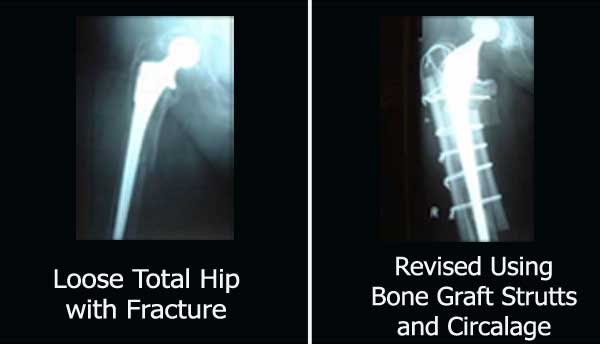Hip Revision Surgery Information for Pateints
Indications
Total hip replacements that have failed either because of wear or for other reasons may require revising or re-doing. The operation is normally carried out for pain arising from a loose hip joint or a hip joint that is showing signs of excessive wear. The operation may also be necessary for progressive bone loss where a loose hip is destroying bone. This may occasionally be a painless process. A revision of the hip is then necessary to stop this process from progressing.
Some hips can become infected. Should this be the case removal of the infected hip becomes essential. This is necessary to eradicate the infection. After an interval of some months and continued antibiotic treatment to remove the infection, a new hip replacement may be inserted. This is known as two-stage revision surgery and is complex and often demanding surgery, dealing with one of the more difficult problems of joint replacement surgery. It requires the co-operation of the patient, and skilled Microbiologists to guide the correct antibiotic therapy for the patients and a dedicated team of doctors, nurses and physiotherapists to achieve the desired end result.
Operation
Revision hip surgery for whatever cause is complex and must be tailored for the individual patient and their problem. The operation is carried out under either a regional (epidural) anaesthetic with sedation or a general anaesthetic depending on the patients’ medical needs. This will be discussed with you by the Consultant Anaesthetist should you need to have such an operation.
Following the operation, the patient may require post-operative support in a High Dependency Unit (HDU) for 24 to 48 hours. Protected mobility (partial weight bearing) maybe necessary for some weeks following such surgery.
Normally the patients return home after some 7 to 10 days following surgery. They should be able to negotiate stairs and walk with two crutches possibly requiring crutches for six weeks. Driving is not permitted for six weeks.
The type of implant used in hip revision surgery is important and is dependant on a number of variable factors. This will be discussed in detail to explain the type of implant to be used and the specific needs for such surgery.
All patients are seen at six weeks for a check up and an X-ray and follow up is continued until satisfactory mobility has been regained. Recovery from such surgery can be prolonged and on occasions additional physiotherapy and hydrotherapy are required to assist the patients’ recovery.

Your surgeon
The reconstruction of a failed hip joint requires expertise in hip joint surgery and is a relatively complex and demanding procedure requiring understanding and compliance from the patient and the attending staff. You should always ensure that your surgeon is sufficiently experienced in such surgery. Mr Drabu would be happy to discuss details of his expertise and experience and results in this field and answer any questions or concerns you may have.
“Thank you for your kindness, consideration and superb skills which have given me a better life now and in the future. You showed complete understanding of my situation and speedily rectified it”.
Mrs D, Cumbria